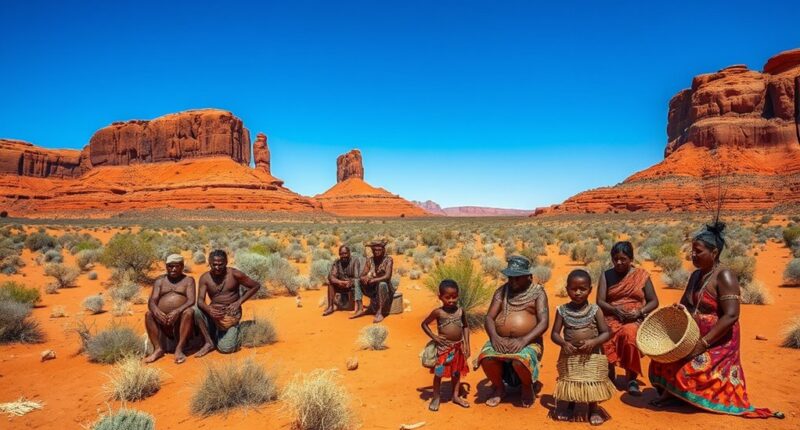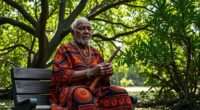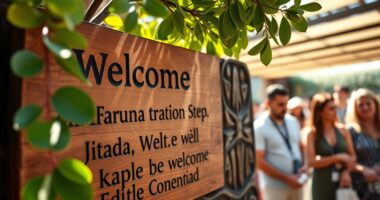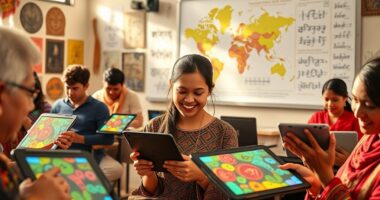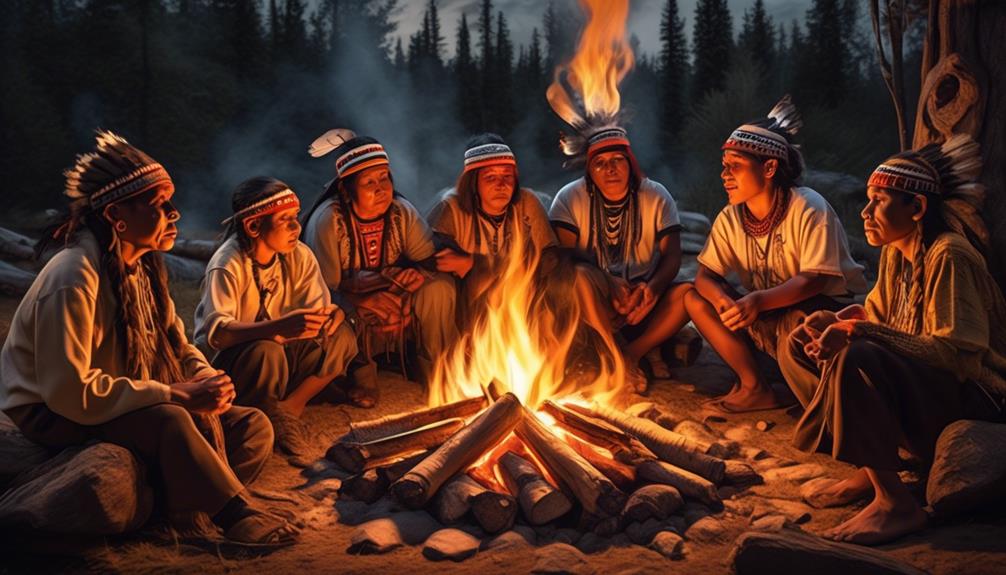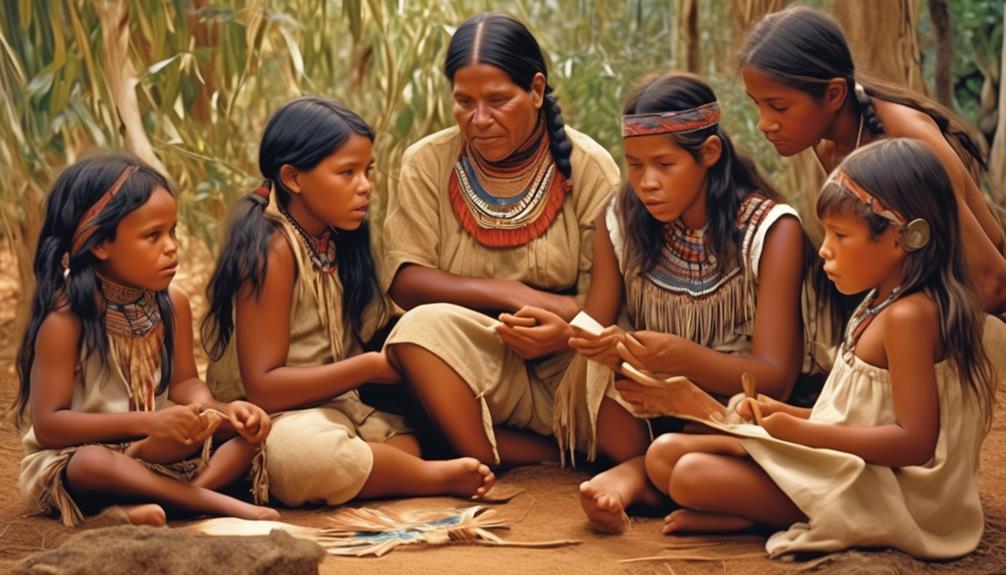You’ll find that Pitjantjatjara and Yankunytjatjara share a common language and cultural roots in the Western Desert, but their dialects, ceremonies, and traditions set them apart. While they understand each other well, differences in pronunciation, stories, and rituals reflect their unique histories and land connections. These variations highlight their resilience and adaptability. If you explore further, you’ll discover how their distinct practices coexist within their shared rich heritage, revealing more about their enduring cultural bond.
Key Takeaways
- Both groups speak dialects of the Western Desert Language, sharing a common linguistic root with variations in pronunciation and vocabulary.
- They participate in ceremonies involving singing, dancing, and rituals tied to Dreamtime stories, reflecting their shared spiritual themes.
- Each group has unique ceremonies, dances, and initiation rituals, highlighting their individual histories and land connections.
- Despite dialect differences, mutual understanding exists, allowing for cultural exchange and shared storytelling traditions.
- Their relationship exemplifies resilience and cultural endurance, maintaining distinct identities while sharing core spiritual and social practices.

The Pitjantjatjara and Yankunytjatjara are closely related Indigenous groups whose cultures and histories are deeply intertwined, yet they also exhibit distinct differences. One of the most noticeable aspects of their relationship is language. You’ll find that their language dialects are closely connected, sharing a common root but evolving separately over time. The Pitjantjatjara speak a dialect of the Western Desert Language, which is characterized by unique pronunciation, vocabulary, and subtle grammatical variations. The Yankunytjatjara, while still part of this linguistic family, have developed their own dialects that reflect their specific regional and social contexts. This means that, although speakers from both groups can generally understand each other, there are nuances that set them apart. These dialect differences are more than just words; they influence how stories are told, how ceremonies are conducted, and how community members communicate within their social circles.
Ceremonial practices are another essential aspect of their shared heritage, yet they also highlight their individual identities. You’ll notice that both groups participate in intricate ceremonies that serve to reinforce social bonds, pass down sacred knowledge, and connect them to their land. These ceremonies often involve singing, dancing, and rituals deeply rooted in Dreamtime stories. While the core spiritual themes are similar, each group has developed its own specific ceremonies, dances, and songs that reflect their unique histories and land. For example, certain initiation rituals or storytelling traditions are exclusive to the Pitjantjatjara or Yankunytjatjara, emphasizing their distinct cultural expressions. Despite these differences, the ceremonies serve as a bridge between the groups, allowing them to share sacred knowledge and maintain their connection to the land and ancestors.
Understanding these differences and shared practices helps you appreciate the richness of their cultural landscape. Their language dialects reveal how they have adapted and preserved their identity through communication, while their ceremonial practices showcase their collective respect for tradition and land. Both groups may have individual ways of expressing their spirituality and social structures, but their shared stories and rituals create a common cultural fabric that binds them. Recognizing these nuances allows you to see how they maintain their unique identities while also celebrating their deep-rooted connection to each other and to their land. Their relationship is a testament to resilience, adaptability, and the enduring power of cultural heritage.
Frequently Asked Questions
How Do Pitjantjatjara and Yankunytjatjara Languages Differ Linguistically?
You’ll notice that Pitjantjatjara and Yankunytjatjara languages differ mainly in their vocabulary and some linguistic structures. While they share many similarities due to common roots, each language has unique words and expressions. The pronunciation and certain grammatical features can also vary slightly, reflecting their distinct cultural identities. These differences help you distinguish between the two, even though they remain mutually intelligible and closely related.
What Are the Traditional Ceremonies Unique to Each Group?
You might think all ceremonies are the same, but each group has its own unique traditions. Pitjantjatjara initiates undergo Dreamtime story rituals that connect them deeply to their ancestors, while Yankunytjatjara ceremonies focus on initiation rites that mark their progression into adulthood. These sacred events vividly embody their cultural identity, blending storytelling with spiritual rites, creating a colorful tapestry of tradition that’s both distinct and shared in their rich heritage.
How Have Modern Influences Impacted Their Cultural Practices?
Modern influences, like urban adaptation and globalization effects, have transformed your cultural practices. You might see younger generations blending traditional ceremonies with new customs, or adopting modern technology to share stories and songs. While these changes can challenge traditional ways, they also create opportunities for cultural preservation in new forms. You adapt by balancing respect for your heritage with embracing modern life, ensuring your traditions stay alive and relevant today.
What Are the Key Differences in Their Land Management Customs?
You’re walking on thin ice if you ignore their land management customs. The Pitjantjatjara emphasize kinship systems that guide land use, with sacred sites protected through cultural expressions rooted in tradition. Yankunytjatjara, however, incorporate more practical approaches, blending their kinship and spiritual beliefs with sustainable practices. While both prioritize connection to land, their customs differ in how they interpret and uphold these responsibilities, reflecting unique cultural identities.
How Do Their Art Styles and Symbols Vary?
You notice that their art styles and symbols differ through distinct symbolic motifs and stylistic techniques. The Pitjantjatjara often use bold, simple lines and earthy colors to depict Dreamtime stories, while the Yankunytjatjara incorporate intricate patterns and brighter hues. These variations reflect their unique cultural expressions, with each group emphasizing different motifs and stylistic approaches that tell their stories and preserve their heritage visually.
Conclusion
As you explore the rich tapestry of Pitjantjatjara and Yankunytjatjara, remember they’re like two branches of the same ancient tree—each unique, yet connected by roots that run deep. When I visited their community, I saw a shared dance that, despite different steps, told the same story. Their heritage reminds you that understanding differences doesn’t weaken bonds; it strengthens them, creating a beautiful, resilient canopy of culture rooted in shared history.
Mary is a passionate writer who brings creativity and a fresh perspective to our team. Her words have the power to captivate and inspire, making her an essential contributor to our content. Mary’s commitment to storytelling and dedication to promoting Indigenous culture ensures that her work touches the hearts of our readers. We’re fortunate to have her as part of our team.
